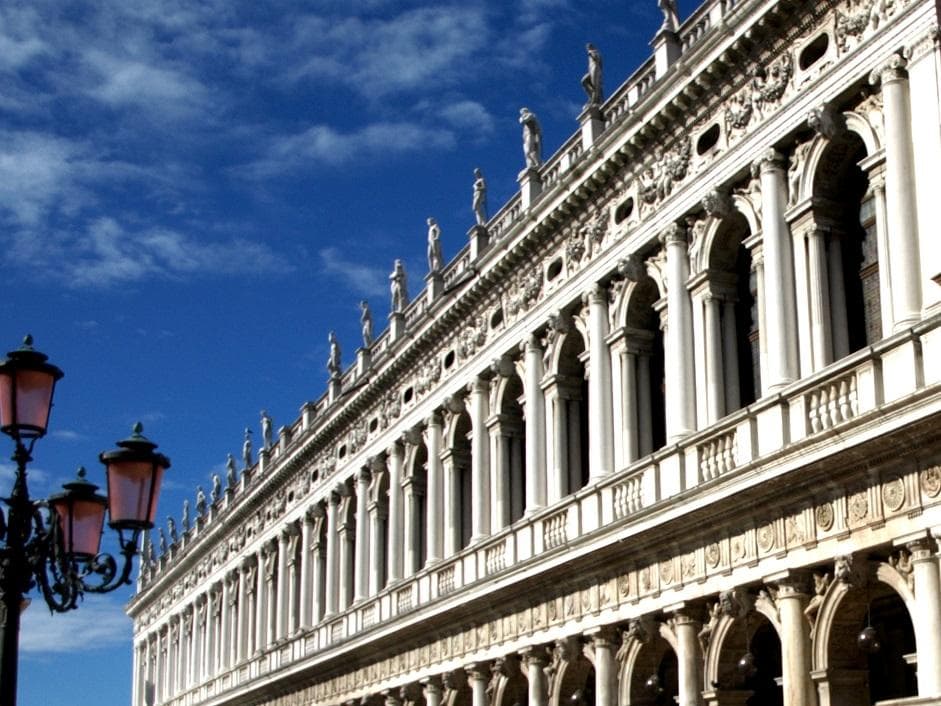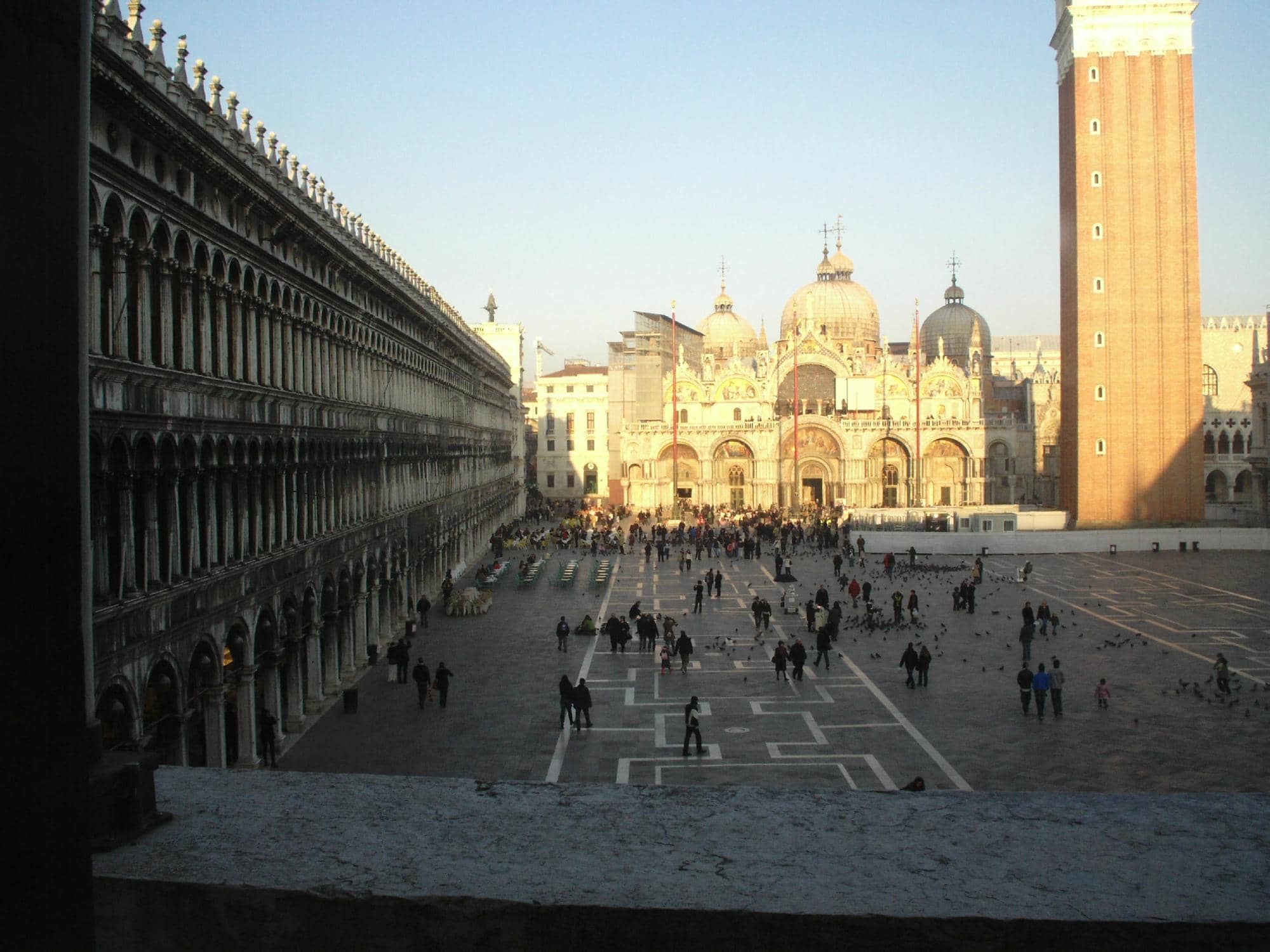
Biblioteca Nazionale Marciana (Monumental Rooms) Venice
Step into a Renaissance masterpiece at the Biblioteca Nazionale Marciana's Monumental Rooms, a treasure of art, architecture, and ancient manuscripts.

Highlights
Must-see attractions

Social
From TikTok & Reddit
Best Time
Fewer crowds, better photos

Biblioteca Nazionale Marciana (Monumental Rooms) Venice
Best Time
Fewer crowds, better photos

Highlights
Must-see attractions
Step into a Renaissance masterpiece at the Biblioteca Nazionale Marciana's Monumental Rooms, a treasure of art, architecture, and ancient manuscripts.
"A breathtaking journey into Venice's intellectual heart, where art and history converge."

🎟️ Book Tickets in Advance
Secure your entry to the Monumental Rooms by booking online to avoid long queues.
🚶♀️ Enter via Archaeological Museum
Consider this route for potentially free access and a unique entry experience.

Highlights
Discover the most iconic attractions and experiences

The Grand Staircase
Entrance to the Monumental Rooms
Ascend the magnificent staircase designed by Sansovino, a masterpiece of Renaissance architecture.

The Reading Room
Main Hall
Marvel at the opulent frescoes, stucco work, and intricate ceiling details of this historic reading room.

Manuscript Collection
Display Cases
Gaze upon priceless ancient manuscripts and rare books, a testament to centuries of knowledge.
Plans like a pro.
Thinks like you
Planning Your Visit
Beat the Crowds for a Magical Experience
Understand the Access Points
Best Times
Insider Tips
from TikTok, Instagram & Reddit
🎟️ Book Tickets in Advance
Secure your entry to the Monumental Rooms by booking online to avoid long queues.
🚶♀️ Enter via Archaeological Museum
Consider this route for potentially free access and a unique entry experience.
📸 Respect the Silence
Photography is often allowed, but maintain a quiet demeanor to respect the library's atmosphere.
⏳ Allow Ample Time
Don't rush; soak in the history and intricate details of this magnificent space.
Tips
from all over the internet
🎟️ Book Tickets in Advance
Secure your entry to the Monumental Rooms by booking online to avoid long queues.
🚶♀️ Enter via Archaeological Museum
Consider this route for potentially free access and a unique entry experience.
📸 Respect the Silence
Photography is often allowed, but maintain a quiet demeanor to respect the library's atmosphere.
⏳ Allow Ample Time
Don't rush; soak in the history and intricate details of this magnificent space.
What Travellers Say
Reviews Summary
Visitors are consistently awestruck by the breathtaking Renaissance architecture and the opulent beauty of the Monumental Rooms, particularly the grand staircase and reading room. The historical significance and the collection of ancient manuscripts are also highly praised, offering a profound glimpse into Venice's intellectual past. Some find the ticketing and access slightly confusing, but the overall experience is overwhelmingly positive.
"I love visiting these older libraries, I really enjoy the vintage antique look they have, I really enjoy reading and books. Many of these older libraries house some of the world’s greatest classical works. This library is absolutely beautiful, it has a very large collection of manuscripts and materials, it’s very well preserved and displayed. I really enjoyed my time here and if you’re into this kinda thing. I would definitely recommend checking it out."
Pong Lenis
"The Marciana National Library, located in the center of Venice, Italy, is a historic institution known across the globe for its extensive collection of manuscripts, early printed books, and magnificent artwork. Its beginnings may be traced back to 1468, when Greek scholar and Cardinal Bessarion willingly donated his personal library to the Venetian Republic to protect it from the Ottoman Empire.
Jacopo Sansovino, a prominent Renaissance architect, began work on the library's current structure in 1537. Completed in 1588, the edifice is a testimony to the architectural splendor of the time. The library's collection has increased dramatically throughout the ages, mainly to contributions from notable individuals, purchases, and the necessary deposit of a copy of every book written in Venice.
Following the collapse of the Venetian Republic in 1811, the library was formally renamed the National Library. Sansovino created the façade, which has statues, columns, and exquisite brickwork. Inside, visitors are met by expansive corridors, quiet reading rooms, and art-filled galleries with stunning murals and exquisite ceilings. The Marciana National Library is more than just a book collection; it is a living witness to the transformative power of knowledge and a treasured cultural legacy."
pegah esmaili
"It is a great pleasure to stand on the Piazzetta and observe this beautiful building, the Biblioteca Marciana. Its history and significance is extremely interesting, and its interior is breathtaking. The interior is beautifully decorated, and richly decorated with frescoes and paintings by artists like Tintoretto and Domenico Molin, its ceiling, featuring Titian’s allegorical painting, Sapienza, is widely considered the room’s most important decorative element. National Library of St. Mark is a library and Renaissance building, one of the oldest public libraries in the country and one of the largest collections of classical texts in the world. The library was named after St. Mark, patron saint of Venice. The Marciana Library stands as a symbol of the city’s wealth and its long tradition of civic investment in intellectual and artistic pursuits. The building’s construction began in 1537 and was completed over the next 50 years. The library, designed by Jacopo Sansovino, he is completed 16 of the façade’s 21 arcaded bays before his death in 1570. Eighteen years later, Vincenzo Scamozzi finished the structure according to Sansovino’s plans. Books for the library began to be collected even before the building was built. The nucleus of the collection was a donation of valuable Byzantine and Renaissance Serenissimi manuscripts collected by the scientist, patron and collector, Cardinal Bessarion, who donated his collection on May 31, 1468. It contained about 750 codices in Latin and Greek, with 250 manuscripts and some printed books (incunabula), it was the first public library open to scholars and students in Venice. The holdings of the Marciana Library were significantly enriched in the 18th century when collections were collected in several monasteries, such as Sts. Giovanni e Paolo from Venice and St. Giovanni di Verdara of Padua, handed over to Marciana for further safekeeping. With the fall of the Venetian Republic in 1797, the Marciana holdings were enriched by the entry of a large number of manuscripts and books from religious institutions (churches and monasteries) that had been banned and disbanded during Napoleon's rule. In 1811, the library was moved to the more spacious premises of the Doge's Palace. In 1904, the collection was moved to the building of Sansovinova Zecca, a mint (built in 1537-1547). The library has since returned to its original space, but has also expanded to parts of the neighboring Procuratie Nuova. Today, Marciana has about a million printed books, and about 13,000 manuscripts, 2,883 incunabula, and 24,055 works printed between 1500 and 1600."
Asiyah Noemi Koso
What People Like
What People Dislike
Frequently Asked Questions
🚇 🗺️ Getting There
The Monumental Rooms are located in St. Mark's Square. You can reach them by Vaporetto (water bus) to the San Marco Vallaresso or San Marco Giardinetti stops. From there, it's a short walk. Many visitors access it as part of the Correr Museum complex.
The main entrance is often integrated with the Correr Museum. Look for signs for the Museo Correr and the Biblioteca Nazionale Marciana. Some suggest entering via the Archaeological Museum for a different approach.
Walking is the most authentic way to explore Venice. For longer distances, the Vaporetto system is efficient. Avoid water taxis unless on a budget, as they can be very expensive.
🎫 🎫 Tickets & Entry
Yes, typically access to the Monumental Rooms is included with a ticket to the Museo Correr and the Doge's Palace. However, some sources suggest entering via the Archaeological Museum might offer free access to certain parts. It's best to check current ticketing policies.
Ticket prices vary depending on whether you purchase a combined ticket for the St. Mark's Square Museums. Historically, accessing the Monumental Rooms might have been free if entering through the Archaeological Museum, but verify this upon arrival.
Opening hours generally align with the Museo Correr and other St. Mark's Square museums. They are typically open daily, but it's crucial to check the official website for the most up-to-date hours, as they can change seasonally.
While tickets may be available on the day, booking in advance online is highly recommended, especially during peak tourist season, to guarantee entry and avoid potentially long queues.
The Monumental Rooms are often accessed through the Museo Correr. Some visitors have found success entering via the Archaeological Museum, which is also part of the St. Mark's Square museum complex.
🎫 🏛️ Onsite Experience
It's renowned for its stunning Renaissance architecture, particularly the grand staircase by Sansovino, and its opulent reading room adorned with frescoes and intricate decorations. It houses a significant collection of ancient manuscripts.
Photography is generally permitted inside the Monumental Rooms, but it's important to be respectful of the environment and other visitors. Tripods and flash photography may be restricted. Always check for signage.
Dress respectfully, as it is a historic and cultural site. Comfortable walking shoes are recommended as you'll be on your feet. Avoid overly casual attire.
A typical visit can take anywhere from 30 minutes to an hour, depending on your interest in the manuscripts and the level of detail you wish to observe.
While official guided tours might be limited, you can often find independent guides in St. Mark's Square. Alternatively, explore at your own pace and use audio guides if available through the museum complex.
🎫 📚 History & Significance
Founded in the mid-16th century, it was one of the most important libraries in Renaissance Italy, intended to preserve and display the intellectual heritage of Venice. It was designed by Jacopo Sansovino.
The library holds a vast collection of Greek, Latin, and Oriental manuscripts, including illuminated codices, historical documents, and scientific treatises, representing centuries of scholarship.
Jacopo Sansovino was a prominent Italian sculptor and architect of the Renaissance. He designed the magnificent staircase and the library building itself, which is considered a masterpiece of Venetian architecture.
For Different Travelers
Tailored advice for your travel style
👨👩👧 Families with Kids
📚 Book Lovers & History Buffs
Deep Dives
In-depth insights and expert knowledge
Architectural Marvels of Sansovino
Inside, the main reading room is an absolute spectacle. Visitors are immediately struck by the lavish frescoes and elaborate stucco work that adorn the walls and ceilings. The intricate details, combined with the rich colors, create an immersive and awe-inspiring atmosphere. This space was designed to inspire contemplation and scholarship, making the act of reading a truly elevated experience. The careful preservation of these decorative elements allows visitors today to step back in time and appreciate the artistic and architectural standards of the Venetian Republic.
A Treasure Trove of Knowledge
The library's mission was to safeguard and disseminate knowledge, making it a vital institution during the Renaissance. The collection reflects Venice's role as a major center of trade and culture, connecting East and West. Exploring the displayed manuscripts provides a tangible link to the past, allowing visitors to connect with the scholars and thinkers who shaped our understanding of the world. It’s a place where history truly comes alive, offering a quiet yet powerful encounter with centuries of human endeavor.






Social
from TikTok, Instagram & Reddit